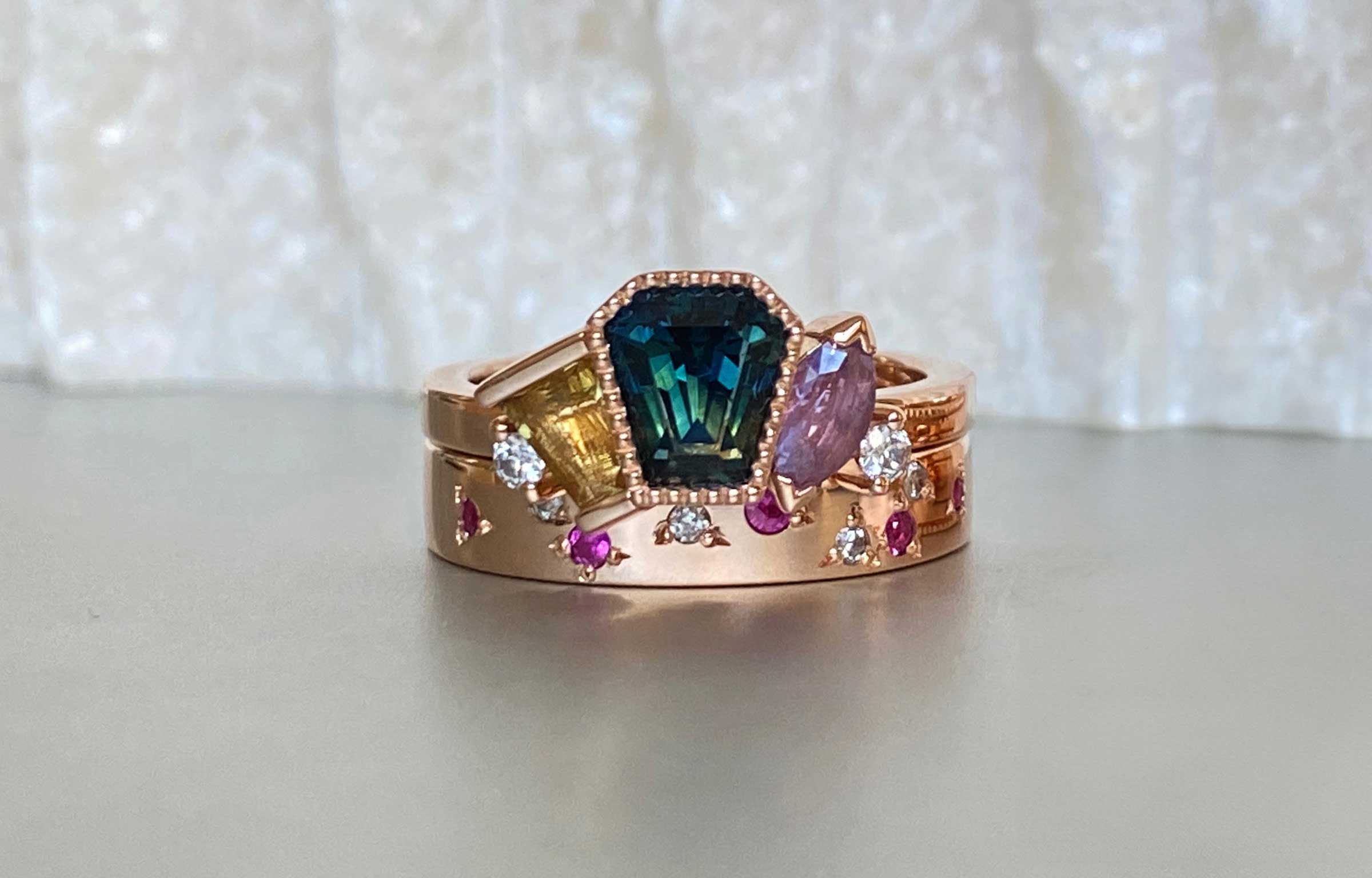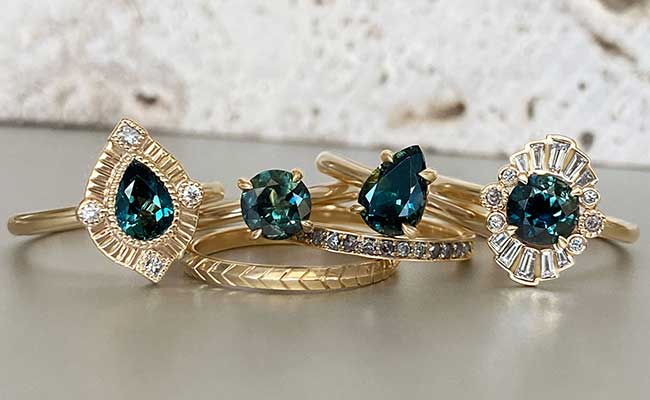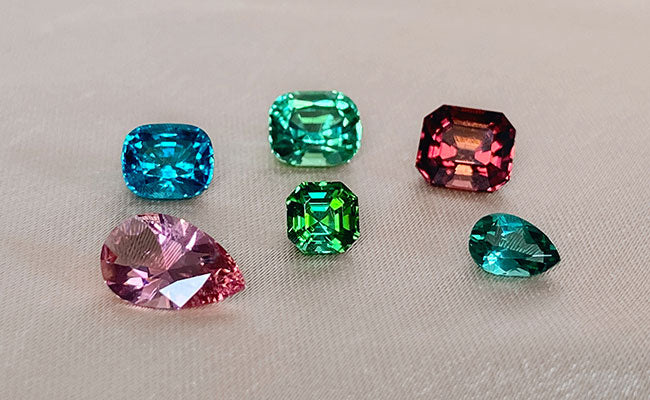
The superhero stone: Why sapphires are one of the ultimate powerhouse gems
If sapphires were a superhero, they'd be one with an unstoppable mix of brains, brawn and beauty.
Their powers?
- Incredible hardness, second only to diamonds out of all the natural gems
- A rainbow of shades, with some rare sapphires even possessing the ability to change colour
- And a secret identity - one you probably didn't see coming
Strong, stunning and full of surprises, sapphires are far more than just beautiful stones. Here's what makes them the ultimate superhero gem.
For those of you who like reading, we end this article with some frequently asked questions about sapphires.

Origin story: Where sapphires come from
Like any great superhero, sapphires have an origin story. And theirs spans the globe.
These gems are found in regions like Sri Lanka, Australia, Madagascar, Myanmar, Tanzania, Thailand and Montana, USA. Each source produces sapphires with unique characteristics, from deep, velvety blue Ceylon sapphires to the parti sapphires of Australia, which feature multiple colours in a single stone.
A trained eye can often make educated guesses about a sapphire's origin based on its colour and characteristics (although definitive assessments must still be made by a qualified gemmologist).
So the next time you admire a sapphire, think about the superhuman journey it took to get to you - millions of years in the earth's crust and a journey from its place of origin - before finding its place in your jewellery collection.

Power of transformation: Sapphires in (almost) every colour
Sapphires are best known for their deep blue hues, but their true power lies in their extraordinary spectrum of colours. From vibrant pinks and fiery oranges to lush greens and vibrant purples, sapphires come in almost every shade imaginable.
One of the rarest and most coveted varieties is the padparadscha sapphire, a stunning blend of pink and orange, reminiscent of a tropical sunset. These sapphires are prized for their colour, making them some of the most valuable sapphires in the world.
Colour-change sapphires have an even more special power. These rare gems shift hues depending on the light, often appearing blue or green in daylight and violet or reddish under artificial light.
But there's one colour you won't find in a sapphire - red. Why? We'll go into that next.

Secret identity: When a sapphire becomes a ruby
Sapphires and rubies share a surprising connection. They are actually the same mineral, corundum.
The only difference? Colour.
While sapphires can appear in nearly every shade, once corundum turns red, it's no longer classified as sapphire. It becomes ruby.
The key to a ruby's colour lies in the trace element, chromium. The more chromium present, the stronger and more vibrant the red.
But here's where things get tricky. How red does corundum need to be before it's called a ruby? The answer isn't always clear cut. Some pinkish-red corundum stones straddle the line between ruby and pink sapphire. Their classification may vary depending on regional standards.
Whether sapphire or ruby is your pick, one thing's for sure. This gemstone's secret identity only adds to its mystique.

Superhuman durability: Sapphire hardness
Every superhero needs a defence mechanism, and for sapphires, that power is hardness. Ranking 9 on the Mohs Hardness Scale, sapphires are one of the hardest natural substances on earth, second only to diamonds. This means they are very resistant to scratches, making them an ideal choice for engagement rings, wedding bands and coloured gemstone pieces that receive daily wear.
However it's important to note that, like superheroes, they aren't indestructible. Sapphires can still scratch, chip and fracture if subjected to significant wear, impact or pressure. While they're far more durable than most coloured gemstones, proper care - such as removing jewellery during exercise - can keep them looking their best.
Find out why sapphires are one of the five unexpected gems you might want to consider for your engagement ring.

High-tech hero: Why sapphires are used in space and tech
Sapphires aren't just admired for their beauty. They have a hidden superpower that makes them invaluable beyond the world of jewellery. Thanks to their exceptional hardness and optical clarity, sapphires are used in high tech industries, from luxury watches to aerospace engineering.
One of their most well-known applications is in scratch resistant watch faces. Brands like Rolex and Omega, among others, use a synthetic form of sapphire to create watch faces that can withstand everyday wear.
But the uses don't stop there. Their ability to endure extreme temperatures, pressure and radiation makes them ideal for satellites, lasers and military-grade optics.
So the next time you admire a sapphire, know that its superhuman properties aren't just for show. They're trusted by some of the most advanced industries on earth (and beyond).

Why you might need sapphire's superpowers in your life
If you're looking for a gemstone that's as tough as it is beautiful, a sapphire might just be your perfect match.
Ready to find the sapphire that tells your story? Explore our collection of curated sapphires or book a consult to start the conversation about a custom sapphire engagement ring.

Sapphire FAQs: All you need to know about nature's superhero gem
For those of you who can't get enough about sapphires, here are some frequently asked questions that'll make you feel like a sapphire expert in no time. If you have any burning questions to add to this list, get in touch and we'll add them.
- Are sapphires good for engagement rings?
- How do I find a sustainably mined and ethically sourced sapphire?
- Why do you, as jeweller, prefer sapphires over diamonds?
- Do sapphires offer more colour choices than diamonds?
- What is the difference between a green sapphire and an emerald?
- Where do blue sapphires come from?
- Where do teal sapphires come from?
- Where do green sapphires come from?
- What is a colour-change sapphire?
- What is the rarest colour of sapphire?
- Is sapphire cheaper than diamond?
- Why do I only see blue sapphires in shops?
- How are sapphires formed?
- Are sapphires a good investment?
Are sapphires good for engagement rings?
Absolutely! Sapphires are one of the best coloured gemstones for engagement rings, offering a stunning mix of beauty, durability and individuality.
Sapphires rank 9 on the Mohs Hardness Scale, making them one of the hardest natural gemstones, second only to diamonds, which rank 10 on the scale. While that may sound like a small difference, it's important to note that the Mohs Hardness Scale is logarithmic, meaning diamonds are significantly harder than sapphires. Diamonds remain the most durable choice for an engagement ring, but if you're looking for a coloured gemstone that can stand up to daily wear, sapphires are an excellent alternative.
How do I find a sustainably mined and ethically sourced sapphire?
The truth? There's no single definition of an "ethical" gemstone. But if conscious consumerism matters to you, here are a few things to look for:
- Gems are hand mined instead of mined with heavy machinery
- Land degradation is minimised during the mining process
- The land is returned to its natural state after it has been mined
- Staff are provided with fair, clean and safe working conditions
- Staff are provided with fair pay for their work
- No child labour is used
- Facilities have water recycling and treatment plans to minimise the impact on the environment
- Renewable energy sources are used to power mining and cutting
A gemstone may not tick every box, but the more it can tick off, the better.
Dive deeper in this guide to ethical gemstones.
Why do you, as jeweller, prefer sapphires over diamonds?
We'll always recommend the best option for our customers, whether it's a sapphire, diamond or something else. Our ultimate goal is to provide fact-based guidance to help you make an informed decision about what's best for you (which may not be the same as what's best for someone else), so the response below is personal opinion rather than a recommendation.
Why do sapphires have us head over heels? When sourcing a diamond, the process is fairly straightforward. If a customer wants an oval diamond of a certain size and proportion, we can typically find multiple options that meet the criteria, that in all honesty, look very similar.
But sapphires are a different story.
If someone asks for a sapphire, the search becomes much more personal. There are more variables to consider (such as intensity and tone of colour, how evenly that colour is distributed throughout the stone and whether it has a mix of hues). There is also often much less stock available that matches specific requirements. If we put them in a line up, the diamonds may be hard to tell apart. But the sapphires will often have their own unique characters, each different from the other.
Do sapphires offer more colour choices than diamonds?
Yes! Sapphires come in almost every colour of the rainbow, while diamonds are mostly found in white (colourless) and coloured diamond shades like champagne, cognac, olive, yellow, grey and salt and pepper. At a significantly higher price point, they are also available in vivid yellows, pinks, blues and greens, although these are extremely rare.
Sapphires naturally exist in a far wider range of colours and are available at a more accessible price point than diamonds of an equivalent size and colour.
View our curated selection of available sapphires or book a consult to find your perfect gem.
What is the difference between a green sapphire and an emerald?
While both gemstones are green, their colour, appearance and durability set them apart.
Green sapphires are a variety of corundum, ranking 9 out of 10 on the Mohs Hardness Scale, making them highly resistant to scratches. Emeralds, on the other hand, belong to the beryl family. Ranking 7.5 - 8 on the Mohs Hardness Scale, they are softer than sapphires and more prone to scratching.
Another key difference is clarity. Emeralds often contain more natural inclusions and imperfections, which can make them more fragile and prone to breakage. Green sapphires tend to have fewer inclusions, making them a more robust choice for everyday jewellery and engagement rings.
In terms of colour, green sapphires display a wider range of hues compared to emeralds, ranging from muted olive tones to deep forest greens to ocean teals (as well as combinations of these colours in a single stone). Emeralds are typically known for their rich, intense green, often with a bluish undertone, though some emeralds are paler depending on their origin.
Both gemstones can be treated to enhance their appearance, but the methods differ. Emeralds are often treated with oil to fill fractures and improve clarity, while green sapphires are commonly heat-treated to enhance clarity and colour. Heating is a permanent treatment on sapphires. On emeralds, oil treatments can be affected by heat and cleaning, so they need to be cared for more gently and may need to be retreated with time.
Both gems are beautiful. However for engagement rings and pieces that are worn everyday, sapphires are a more durable choice.
Where do blue sapphires come from?
Blue sapphires are (or have been, in the case of the largely depleted Kashmiri and Burmese mines) found in several locations around the world. Here are some of the areas that the more sought-after blue sapphires come from.
- Australia: Australian blue sapphires are often a darker blue than other regions and can have a unique mix of colours in a single stone.
- Burma (Myanmar): Burma produces rich, royal blue sapphires with high saturation.
- Kashmir: Kashmiri sapphires are famous for their velvety, deep blue colour and exceptional quality.
- Madagascar: Madagascar is a newer but significant source of high quality stones, often showing a mix of blue, teal and green.
- Montana, USA: Montana sapphires feature a distinctive steel-blue or blue-green tone.
- Sri Lanka (Ceylon): Ceylon sapphires are known for their bright, vibrant blues with excellent clarity.
- Tanzania: Tanzania is a lesser known source with a diverse selection of colours, including bold, mixed-colour blue, purple and pink sapphires from the Winza region.
Where do teal sapphires come from?
Teal sapphires, celebrated for their blend of blue and green hues, are sourced from various regions worldwide.
- Australia: Particularly in Queensland and New South Wales, Australia is known for producing teal sapphires with deep, rich colours. Australian sapphires are often on the darker side, due to their iron content.
- Montana, USA: Montana's sapphire deposits, especially from areas like the Missouri River and Rock Creek, yield teal sapphires that typically display softer, pastel tones.
- Madagascar: Madagascan teal sapphires are known for their more vibrant colours, sometimes with unique colour zoning. Madagascan sapphires tend to be brighter and lighter than Australian sapphires, because they don't contain iron.
Where do green sapphires come from?
Green sapphires are found in Australia, Sri Lanka, Thailand and Madagascar. Their colour is a result of trace amounts of iron within the crystal structure. Depending on the concentration of iron, green sapphires can range from pale mint to deep forest green. Some green sapphires also exhibit a secondary yellow or blue tone.

What is a colour-change sapphire?
A colour-change sapphire is a rare and fascinating type of sapphire that changes colour under different lighting conditions. It may look blue or greenish in daylight or fluorescent light, and purple or reddish in incandescent or warm indoor lighting.
The degree of colour-change varies. Some sapphires display a subtle shift in colour (and tend to be called "colour shift sapphires") while others change in colour more dramatically. This effect is caused by trace elements within the sapphire, such as chromium and vanadium, which affect how the stone absorbs and reflects light from different sources. Since colour-change sapphires are much rarer than non colour-change sapphires, they are highly sought after by collectors and gemstone lovers alike.
What is the rarest colour of sapphire?
The rarest colour of sapphire is the padparadscha sapphire, a stunning blend of pink and orange. Named after the lotus flower, these sapphires are highly sought after and command premium prices.
Is sapphire cheaper than diamond?
Yes, sapphires are generally more affordable than diamonds of the same size or weight. While rare sapphires can fetch high prices, they still tend to cost significantly less than a diamond would in an equivalent colour and size.
Why do I only see blue sapphires in shops?
Blue sapphires dominate most jewellery store displays because they are the most commercially popular variety. Pastel blue, cornflower blue and royal blue sapphires are often used in classic engagement rings, making them the go-to choice for mainstream jewellers.
But if you've read this far, you know there is a whole world of extraordinary sapphires out there, beyond the traditional blue.
At Fairina Cheng, unconventional, rare and non-traditional sapphires make our jeweller hearts sing. These are the ones you're much less likely to find in traditional boutiques and chain stores. Book a consult to find your perfect, storytelling sapphire or shop our sapphire collection.
How are sapphires formed?
Sapphires form deep within the earth's crust, under extreme heat and pressure over millions of years. They originate from aluminium oxide (corundum) that crystallises under high pressure conditions. Over time, trace elements such as iron, titanium and vanadium interact with the corundum, giving sapphires their distinct colours. They are often found in alluvial deposits, where water and erosion transport them from where they formed to riverbeds and gravel deposits.
Are sapphires a good investment?
Sapphires can be an excellent investment, particularly rare or high quality stones with strong provenance. Fine sapphires, especially untreated gems from sources like Kashmir, Burma or Sri Lanka, tend to appreciate in value. If purchasing a sapphire as an investment, look for natural, untreated stones with strong colour saturation and minimal inclusions.
Your sapphire story starts here
Super strong. Stunningly unique. Full of surprises.
If you're ready to find your perfect sapphire - one that's as bold and meaningful as your story - let's make it happen. Book a consult and let's craft something unforgettable.






